Research Progress on the Application of Triboelectric Nanogenerators for Wind Energy Collection
Abstract
:1. Introduction
2. Structural Design and Power Generation Principal Analysis of ST-TENG
2.1. Basic Theory of the TENG and the Working Principle
2.2. The Principle of Static Electricity
2.3. Friction Layer Material
3. Wind Energy Model Based on Triboelectric Nanogenerators
4. Application of Triboelectric Nanogenerators in Wind Energy Harvesting
4.1. Wind Energy Harvesting Based on Rotating Structure
4.1.1. Wind Energy Harvesting Based on Rotating Structure for AC Discharge
4.1.2. Wind Energy Harvesting Based on Rotating Structure for Direct Current Discharge

4.1.3. Construction of Self-Regulating Triboelectric Nanogenerators for Wind Energy Harvesting
4.2. Wind Energy Harvesting Based on Vibration Triboelectricity
5. The Factors That Can Modify Triboelectric Nanogenerators to Improve Performance
5.1. Output Stability
5.2. Output Performance of a TENG for Harvesting Wind Energy
5.3. Lifetime of a TENG Applied to Harvest Wind Energy
6. Conclusions and Prospect
Author Contributions
Funding
Data Availability Statement
Conflicts of Interest
Abbreviations
| Abbreviation | Expansion |
| TENG | Triboelectric nanogenerators |
| BD-TENG | Breeze-driven triboelectric nanogenerator |
| TEHG | Triboelectric-electromagnetic hybrid nanogenerator |
| RTS-TENG | Real-time signal output terminal structure Triboelectric nanogenerators |
| WB-TENG | Triboelectric nanogenerator based on rolling motion of beads |
| DAS-TENG | Deformable, arch-shaped, film-based direct-current triboelectric nanogenerator |
| RTS-TENG | Organic semiconductor/metal Schottky heterojunction based direct current triboelectric nanogenerator |
| BD-TENG | Bidirectional direct current triboelectric nanogenerator with the mechanical rectifier |
| TENG-SS | Self-regulation strategy for triboelectric nanogenerator |
| SA-TENG | Driving-torque self-adjusted triboelectric nanogenerator |
| WG-TENG | Wake-galloping-driven triboelectric nanogenerator |
| GTENG | Gaslloping triboelectric nanogenerator |
| VIV-TENG | Vortex-induced vibration triboelectric nanogenerator |
| W-TENG | Wind-powered triboelectric nanogenerator |
| B-TENG | Bernoulli effect-dominated triboelectric nanogenerator |
| C-TENG | Calliopsis-inspired biomimetic triboelectric nanogenerator |
| TD-TENG | Unique turbine disk-type triboelectric nanogenerator |
| AS-TENG | Angle-shaped triboelectric nanogenerator |
| P-TENG | Pendulum triboelectric nanogenerator |
| MS-TENG | Magnetic-switch-structured triboelectric nanogenerator |
| G-TENG | Gravity triboelectric nanogenerator |
| RL-TENG | Roller-shaped TENG |
| R-DC-TENG | Direct-current triboelectric nanogenerator |
| WM-TENG | Wind-monitoring triboelectric nanogenerator |
References
- Kim, W.G.; Kim, D.W.; Tcho, I.W.; Kim, J.K.; Kim, M.S.; Choi, Y.K. Triboelectric Nanogenerator: Structure, Mechanism, and Applications. ACS Nano 2021, 15, 258–287. [Google Scholar] [CrossRef] [PubMed]
- Yan, J.; Tang, Z.; Mei, N.; Zhang, D.; Zhong, Y.; Sheng, Y. Triboelectric nanogenerators for efficient low-frequency ocean wave energy harvesting with swinging boat configuration. Micromachines 2023, 14, 748. [Google Scholar] [CrossRef] [PubMed]
- Balat, M.; Ayar, G.; Oguzhan, C.; Uluduz, H.; Faiz, U. Influence of fossil energy applications on environmental pollution. Energy Source Part B 2007, 2, 213–226. [Google Scholar] [CrossRef]
- Cantarero, M.M.V. Of renewable energy, energy democracy, and sustainable development: A roadmap to accelerate the energy transition in developing countries. Energy Res. Soc. Sci. 2020, 70, 101716. [Google Scholar] [CrossRef]
- Downie, C. Strategies for Survival: The international energy agency’s response to a new world. Energy Policy 2020, 141, 111452. [Google Scholar] [CrossRef]
- Cheng, T.; Shao, J.; Wang, Z.L. Triboelectric nanogenerators. Nat. Rev. Methods Primers 2023, 3, 39. [Google Scholar] [CrossRef]
- Wang, Z.L. From contact-electrification to triboelectric nanogenerators. Rep. Prog. Phys. 2021, 84, 096502. [Google Scholar] [CrossRef]
- Cheng, J.; Ding, W.; Zi, Y.; Lu, Y.; Ji, L.; Liu, F.; Wu, C.; Wang, Z.L. Triboelectric microplasma powered by mechanical stimuli. Nat. Commun. 2018, 9, 3733. [Google Scholar] [CrossRef] [Green Version]
- Fan, F.-R.; Tian, Z.-Q.; Wang, Z.L. Flexible triboelectric generator. Nano Energy 2012, 1, 328–334. [Google Scholar] [CrossRef]
- Zhao, J.; Zhen, G.; Liu, G.; Bu, T.; Liu, W.; Fu, X.; Zhang, P.; Zhang, C.; Wang, Z.L. Remarkable merits of triboelectric nanogenerator than electromagnetic generator for harvesting small-amplitude mechanical energy. Nano Energy 2019, 61, 111–118. [Google Scholar] [CrossRef]
- García-Casas, X.; Ghaffarinejad, A.; Aparicio, F.J.; Castillo-Seoane, J.; López-Santos, C.; Espinós, J.P.; Cotrino, J.; Sánchez-Valencia, J.R.; Barranco, Á.; Borrás, A. Plasma engineering of microstructured piezo-triboelectric hybrid nanogenerators for wide bandwidth vibration energy harvesting. Nano Energy 2022, 91, 106673. [Google Scholar] [CrossRef]
- Ren, Z.; Wu, L.; Zhang, J.; Wang, Y.; Wang, Y.; Li, Q.; Wang, F.; Liang, X.; Yang, R. Trapezoidal cantilever-structure triboelectric nanogenerator integrated with a power management module for low-frequency vibration energy harvesting. ACS Appl. Mater. Interfaces 2022, 14, 5497–5505. [Google Scholar] [CrossRef] [PubMed]
- Fan, K.; Wei, D.; Zhang, Y.; Wang, P.; Tao, K.; Yang, R. A whirligig-inspired intermittent-contact triboelectric nanogenerator for efficient low-frequency vibration energy harvesting. Nano Energy 2021, 90, 106576. [Google Scholar] [CrossRef]
- Hou, K.-X.; Dai, X.; Zhao, S.-P.; Huang, L.-B.; Li, C.-H. A damage-tolerant, self-healing and multifunctional triboelectric nanogenerator. Nano Energy 2023, 116, 108739. [Google Scholar] [CrossRef]
- Xiao, Z.; Luo, Y.; Yuan, H.; Zheng, T.; Xu, S.; Dai, G.; Yang, J. Coupling Charge Pump and BUCK Circuits to Efficiently Enhance the Output Performance of Triboelectric Nanogenerator. Nano Energy 2023, 115, 108749. [Google Scholar] [CrossRef]
- Karthikeyan, V.; Vivekanandan, S. Optimize an effective triboelectric nanogenerator surface morphology to harvest the human wrist pulse pressure: A numerical study on finite element method. Heliyon 2022, 8, e12109. [Google Scholar] [CrossRef]
- Peng, W.; Ni, Q.; He, L.; Liao, Q. Foam nickel-PDMS composite film based triboelectric nanogenerator for speed and acceleration sensing. Heliyon 2023, 9, e17467. [Google Scholar] [CrossRef] [PubMed]
- Shi, Q.; Zhang, Z.; Yang, Y.; Shan, X.; Salam, B.; Lee, C. Artificial Intelligence of Things (AIoT) Enabled Floor Monitoring System for Smart Home Applications. ACS Nano 2021, 15, 18312–18326. [Google Scholar] [CrossRef]
- Guo, H.; Wen, Z.; Zi, Y.; Yeh, M.-H.; Wang, J.; Zhu, L.; Hu, C.; Wang, Z.L. A water-proof triboelectric–electromagnetic hybrid generator for energy harvesting in harsh environments. Adv. Energy Mater. 2016, 6, 1501593. [Google Scholar] [CrossRef]
- Quan, Z.; Han, C.B.; Jiang, T.; Wang, Z.L. Robust Thin Films-Based Triboelectric Nanogenerator Arrays for Harvesting Bidirectional Wind Energy. Adv. Energy Mater. 2016, 6, 1501799. [Google Scholar] [CrossRef]
- Dai, H.L.; Abdelkefi, A.; Yang, Y.; Wang, L. Orientation of bluff body for designing efficient energy harvesters from vortex-induced vibrations. Appl. Phys. Lett. 2016, 108, 053902. [Google Scholar] [CrossRef]
- Zeng, Q.; Wu, Y.; Tang, Q.; Liu, W.; Wu, J.; Zhang, Y.; Yin, G.; Yang, H.; Yuan, S.; Tan, D.; et al. A high-efficient breeze energy harvester utilizing a full-packaged triboelectric nanogenerator based on flow-induced vibration. Nano Energy 2020, 70, 104524. [Google Scholar] [CrossRef]
- Abdelkefi, A.; Nuhait, A.O. Modeling and performance analysis of cambered wing-based piezoaeroelastic energy harvesters. Smart Mater. Struct. 2013, 22, 95029. [Google Scholar] [CrossRef]
- Yan, Z.; Wang, L.; Hajj, M.R.; Yan, Z.; Sun, Y.; Tan, T. Energy harvesting from iced-conductor inspired wake galloping. Extrem. Mech. Lett. 2020, 35, 100633. [Google Scholar] [CrossRef]
- Gao, X.; Huang, M.; Zou, G.; Li, X.; Wang, Y. Self-powered vibration sensor based on the coupling of dual-mode triboelectric nanogenerator and non-contact electromagnetic generator. Nano Energy 2023, 111, 2211–2855. [Google Scholar] [CrossRef]
- Munirathinam, P.; Mathew, A.A.; Shanmugasundaram, V.; Vivekananthan, V.; Purusothaman, Y.; Kim, S.-J.; Chandrasekhar, A. A comprehensive review on triboelectric nanogenerators based on Real-Time applications in energy harvesting and Self-Powered sensing. Mater. Sci. Eng. B 2023, 297, 116762. [Google Scholar] [CrossRef]
- Alam, S.N.; Ghosh, A.; Shrivastava, P.; Shukla, U.; Garg, K.; Edara, A.C.; Sahoo, N. An introduction to triboelectric nanogenerators. Nano-Struct. Nano-Objects 2023, 34, 100980. [Google Scholar] [CrossRef]
- Khushboo; Azad, P. Design, analysis of a synchronized interface circuit for triboelectric energy harvesting. J. Electron. Mater. 2020, 49, 2491–2501. [Google Scholar] [CrossRef]
- Luo, J.; Wang, Z.L. Recent progress of triboelectric nanogenerators: From fundamental theory to practical applications. EcoMat 2020, 2, e12059. [Google Scholar] [CrossRef]
- Wang, J.; Wu, C.; Dai, Y.; Zhao, Z.; Wang, A.; Zhang, T.; Wang, Z.L. Achieving ultrahigh triboelectric charge density for efficient energy harvesting. Nat. Commun. 2017, 8, 88. [Google Scholar] [CrossRef] [Green Version]
- Wang, Z.L. Triboelectric nanogenerators as new energy technology and self-powered sensors—Principles, problems and perspectives. Faraday Discuss. 2014, 176, 447–458. [Google Scholar] [CrossRef] [PubMed]
- Mallineni, S.S.K.; Dong, Y.; Behlow, H.; Rao, A.M.; Podila, R. A wireless triboelectric nanogenerator. Adv. Energy Mater. 2018, 8, 1702736. [Google Scholar] [CrossRef] [Green Version]
- Liu, C.-Y.; Bard, A.J. Electrons on dielectrics and contact electrification. Chem. Phys. Lett. 2009, 480, 145–156. [Google Scholar] [CrossRef]
- Wang, Z.L.; Wang, A.C. On the origin of contact-electrification. Mater. Today 2019, 30, 34–51. [Google Scholar] [CrossRef]
- Wang, X.; Hu, C.G.; Han, Z. Recent progress on triboelectric nanogenerator for wind and blue energy harvesting. Exp. Phys. 2021, 41, 1–16. (In Chinese) [Google Scholar]
- Xu, C.; Zi, Y.; Wang, A.C.; Zou, H.; Dai, Y.; He, X.; Wang, P.; Wang, Y.-C.; Feng, P.; Li, D.; et al. On the electron-transfer mechanism in the contact-electrification effect. Adv. Mater. 2018, 30, 1706790. [Google Scholar] [CrossRef]
- Zhou, Y.S.; Liu, Y.; Zhu, G.; Lin, Z.-H.; Pan, C.; Jing, Q.; Wang, Z.L. In Situ quantitative study of nanoscale triboelectrification and patterning. Nano Lett. 2013, 13, 2771–2776. [Google Scholar] [CrossRef] [Green Version]
- Wang, J.; Ding, W.; Pan, L.; Wu, C.; Yu, H.; Yang, L.; Liao, R.; Wang, Z.L. Self-powered wind sensor system for detecting wind speed and direction based on a triboelectric nanogenerator. ACS Nano 2018, 12, 3954–3963. [Google Scholar] [CrossRef]
- Lone, S.A.; Lim, K.C.; Kaswan, K.; Chatterjee, S.; Fan, K.-P.; Choi, D.; Lee, S.; Zhang, H.; Cheng, J.; Lin, Z.-H. Recent advancements for improving the performance of triboelectric nanogenerator devices. Nano Energy 2022, 99, 107318. [Google Scholar] [CrossRef]
- Walden, R.; Aazem, I.; Babu, A.; Pillai, S.C. Textile-Triboelectric nanogenerators (T-TENGs) for wearable energy harvesting devices. Chem. Eng. J. 2023, 451, 138741. [Google Scholar] [CrossRef]
- Shao, Z.; Chen, J.; Li, P.; Gao, K.; Yang, S.; Xiong, M.; Fu, Q.; Li, P.; Mi, L. Static inductive effect: A novel enhancement strategy for the output performance of organic triboelectric nanogenerator. Dye Pigment. 2022, 207, 110682. [Google Scholar] [CrossRef]
- Mathew, A.A.; Chandrasekhar, A.; Vivekanandan, S. A review on real-time implantable and wearable health monitoring sensors based on triboelectric nanogenerator approach. Nano Energy 2021, 80, 105566. [Google Scholar] [CrossRef]
- Cui, S.; Liu, D.; Yang, P.; Liu, J.; Gao, Y.; Zhao, Z.; Zhou, L.; Zhang, J.; Wang, Z.L.; Wang, J. Triboelectric-material-pairs selection for direct-current triboelectric nanogenerators. Nano Energy 2023, 112, 108509. [Google Scholar] [CrossRef]
- Jeon, S.-B.; Kim, S.; Park, S.-J.; Seol, M.-L.; Kim, D.; Chang, Y.K.; Choi, Y.-K. Self-powered electro-coagulation system driven by a wind energy harvesting triboelectric nanogenerator for decentralized water treatment. Nano Energy 2016, 28, 288–295. [Google Scholar] [CrossRef]
- Su, Y.; Xie, G.; Xie, T.; Zhang, H.; Ye, Z.; Jing, Q.; Tai, H.; Du, X.; Jiang, Y. Wind energy harvesting and self-powered flow rate sensor enabled by contact electrification. J. Phys. D Appl. Phys. 2016, 49, 215601. [Google Scholar] [CrossRef]
- Li, W.; Guo, H.; Xi, Y.; Wang, C.; Javed, M.S.; Xia, X.; Hu, C. WGUs sensor based on integrated wind-induced generating units for 360° wind energy harvesting and self-powered wind velocity sensing. RSC Adv. 2017, 7, 23208–23214. [Google Scholar] [CrossRef] [Green Version]
- Jiang, Q.; Chen, B.; Yang, Y. Wind-Driven Triboelectric Nanogenerators for Scavenging Biomechanical Energy. ACS Appl. Energy Mater. 2018, 1, 4269–4276. [Google Scholar] [CrossRef]
- Olsen, M.; Zhang, R.; Örtegren, J.; Andersson, H.; Yang, Y.; Olin, H. Frequency and voltage response of a wind-driven fluttering triboelectric nanogenerator. Sci. Rep. 2019, 9, 5543. [Google Scholar] [CrossRef] [Green Version]
- Lu, S.; Gao, L.; Chen, X.; Tong, D.; Lei, W.; Yuan, P.; Mu, X.; Yu, H. Simultaneous energy harvesting and signal sensing from a single triboelectric nanogenerator for intelligent self-powered wireless sensing systems. Nano Energy 2020, 75, 104813. [Google Scholar] [CrossRef]
- Ren, Z.; Ding, Y.; Nie, J.; Wang, F.; Xu, L.; Lin, S.; Chen, X.; Wang, Z.L. Environmental Energy Harvesting Adapting to Different Weather Conditions and Self-Powered Vapor Sensor Based on Humidity-Responsive Triboelectric Nanogenerators. ACS Appl. Mater. Interfaces 2019, 11, 6143–6153. [Google Scholar] [CrossRef]
- Shao, Z.; Chen, J.; Xie, Q.; Mi, L. Functional metal/covalent organic framework materials for triboelectric nanogenerator. Coord. Chem. Rev. 2023, 486, 215118. [Google Scholar] [CrossRef]
- Cheng, K.; Wallaert, S.; Ardebili, H.; Karim, A. Advanced triboelectric nanogenerators based on low-dimension carbon materials: A review. Carbon 2022, 194, 81–103. [Google Scholar] [CrossRef]
- Xia, R.; Zhang, R.; Jie, Y.; Zhao, W.; Cao, X.; Wang, Z. Natural cotton-based triboelectric nanogenerator as a self-powered system for efficient use of water and wind energy. Nano Energy 2022, 92, 106685. [Google Scholar] [CrossRef]
- Zhao, L.-C.; Zou, H.-X.; Yan, G.; Liu, F.-R.; Tan, T.; Zhang, W.-M.; Peng, Z.-K.; Meng, G. A water-proof magnetically coupled piezoelectric-electromagnetic hybrid wind energy harvester. Appl. Energy 2019, 239, 735–746. [Google Scholar] [CrossRef]
- Patel, M.R. Wind and Solar Power Systems, Design, Analysis, Operation; CRC Press: Boca Raton, FL, USA, 2006. [Google Scholar]
- Zou, H.-X.; Zhao, L.-C.; Wang, Q.; Gao, Q.-H.; Yan, G.; Wei, K.-X.; Zhang, W.-M. A self-regulation strategy for triboelectric nanogenerator and self-powered wind-speed sensor. Nano Energy 2022, 95, 106990. [Google Scholar] [CrossRef]
- Ren, Z.; Wang, Z.; Liu, Z.; Wang, L.; Guo, H.; Li, L.; Li, S.; Chen, X.; Tang, W.; Wang, Z.L. Energy harvesting from breeze wind (0.7–6 m s−1) using ultra-stretchable triboelectric nanogenerator. Adv. Energy Mater. 2020, 10, 2001770. [Google Scholar] [CrossRef]
- Ali, M.; Khan, S.A.; Shamsuddin; Ali, A.; Ali, S.; Hassan, R.U.; Cho, D.-H.; Byun, D. Low Profile Wind Savonius Turbine Triboelectric Nanogenerator for Powering Small Electronics. Sens. Actuators A Phys. 2023, 114535. [Google Scholar] [CrossRef]
- Xia, K.; Xu, Z.; Hong, Y.; Wang, L. A free-floating structure triboelectric nanogenerator based on natural wool ball for offshore wind turbine environmental monitoring. Mater. Today Sustain. 2023, 100467. [Google Scholar] [CrossRef]
- Ren, Z.; Wu, L.; Pang, Y.; Zhang, W.; Yang, R. Strategies for effectively harvesting wind energy based on triboelectric nanogenerators. Nano Energy 2022, 100, 107522. [Google Scholar] [CrossRef]
- Li, X.; Cao, Y.; Yu, X.; Xu, Y.; Yang, Y.; Liu, S.; Cheng, T.; Wang, Z.L. Breeze-driven triboelectric nanogenerator for wind energy harvesting and application in smart agriculture. Appl. Energy 2021, 306, 117977. [Google Scholar] [CrossRef]
- Gui, Y.; Wang, Y.; He, S.; Yang, J. Self-powered smart agriculture real-time sensing device based on hybrid wind energy harvesting triboelectric-electromagnetic nanogenerator. Energy Convers. Manag. 2022, 269, 116098. [Google Scholar] [CrossRef]
- Fan, X.; He, J.; Mu, J.; Qian, J.; Zhang, N.; Yang, C.; Hou, X.; Geng, W.; Wang, X.; Chou, X. Triboelectric-electromagnetic hybrid nanogenerator driven by wind for self-powered wireless transmission in Internet of Things and self-powered wind speed sensor. Nano Energy 2019, 68, 104319. [Google Scholar] [CrossRef]
- Huang, L.-B.; Xu, W.; Bai, G.; Wong, M.-C.; Yang, Z.; Hao, J. Wind energy and blue energy harvesting based on magnetic-assisted noncontact triboelectric nanogenerator. Nano Energy 2016, 30, 36–42. [Google Scholar] [CrossRef]
- Zhu, Z.; Xiang, H.; Zeng, Y.; Zhu, J.; Cao, X.; Wang, N.; Wang, Z.L. Continuously harvesting energy from water and wind by pulsed triboelectric nanogenerator for self-powered seawater electrolysis. Nano Energy 2022, 93, 106776. [Google Scholar] [CrossRef]
- Kim, D.; Tcho, I.-W.; Choi, Y.-K. Triboelectric nanogenerator based on rolling motion of beads for harvesting wind energy as active wind speed sensor. Nano Energy 2018, 52, 256–263. [Google Scholar] [CrossRef]
- Li, H.; Zhang, Y.; Gao, Z.; Liang, L.; Wang, X.; Liu, X.; Wu, Y.; Zheng, H. Modular design and fully packed triboelectric nanogenerator based on escapement mechanism for harvesting high entropy energy in harsh environments. Nano Energy 2023, 109, 108266. [Google Scholar] [CrossRef]
- Fan, K.; Chen, C.; Zhang, B.; Li, X.; Wang, Z.; Cheng, T.; Wang, Z.L. Robust triboelectric-electromagnetic hybrid nanogenerator with maglev-enabled automatic mode transition for exploiting breeze energy. Appl. Energy 2022, 328, 120218. [Google Scholar] [CrossRef]
- Song, M.; Hur, J.; Heo, D.; Chung, S.-H.; Kim, D.; Kim, S.; Kim, D.; Lin, Z.-H.; Chung, J.; Lee, S. Current amplification through deformable arch-shaped film based direct-current triboelectric nanogenerator for harvesting wind energy. Appl. Energy 2023, 344, 121248. [Google Scholar] [CrossRef]
- You, Z.Y.; Wang, X.; Lu, F.; Wang, S.; Hu, B.; Li, L.; Fang, W.; Liu, Y. An organic semiconductor/metal Schottky heterojunction based direct current triboelectric nanogenerator windmill for wind energy harvesting. Nano Energy 2023, 109, 108302. [Google Scholar] [CrossRef]
- Liu, D.; Bao, J.-F.; Chen, Y.-L.; Li, G.-K.; Zhang, X.-S. Unidirectional-current triboelectric nanogenerator based on periodical lateral-cantilevers. Nano Energy 2020, 74, 104770. [Google Scholar] [CrossRef]
- Wang, J.; Wu, Z.; Pan, L.; Gao, R.; Zhang, B.; Yang, L.; Guo, H.; Liao, R.; Wang, Z.L. Direct-current rotary-tubular triboelectric nanogenerators based on liquid-dielectrics contact for sustainable energy harvesting and chemical composition analysis. ACS Nano 2019, 13, 2587–2598. [Google Scholar] [CrossRef] [PubMed]
- Zhang, C.; Zhou, T.; Tang, W.; Han, C.; Zhang, L.; Wang, Z.L. Rotating-disk-based direct-current triboelectric nanogenerator. Adv. Energy Mater. 2014, 4, 1301798. [Google Scholar] [CrossRef]
- Qiao, G.; Wang, J.; Yu, X.; Jia, R.; Cheng, T.; Wang, Z.L. A bidirectional direct current triboelectric nanogenerator with the mechanical rectifier. Nano Energy 2021, 79, 105408. [Google Scholar] [CrossRef]
- Zhao, Z.; Liu, D.; Li, Y.; Wang, Z.L.; Wang, J. Direct-current triboelectric nanogenerator based on electrostatic breakdown effect. Nano Energy 2022, 102, 107745. [Google Scholar] [CrossRef]
- Wang, Y.; Li, X.; Yu, X.; Zhu, J.; Shen, P.; Wang, Z.L.; Cheng, T. Driving-torque self-adjusted triboelectric nanogenerator for effective harvesting of random wind energy. Nano Energy 2022, 99, 107389. [Google Scholar] [CrossRef]
- Xu, M.; Wang, Y.-C.; Zhang, S.L.; Ding, W.; Cheng, J.; He, X.; Zhang, P.; Wang, Z.; Pan, X.; Wang, Z.L. An aeroelastic flutter based triboelectric nanogenerator as a self-powered active wind speed sensor in harsh environment. Extrem. Mech. Lett. 2017, 15, 122–129. [Google Scholar] [CrossRef]
- Yuan, S.; Zeng, Q.; Tan, D.; Luo, Y. Scavenging breeze wind energy (1–8.1 ms−1) by minimalist triboelectric nanogenerator based on the wake galloping phenomenon. Nano Energy 2022, 100, 107465. [Google Scholar] [CrossRef]
- Doaré, O.; Sauzade, M.; Eloy, C. Flutter of an elastic plate in a channel flow: Confinement and finite-size effects. J. Fluids Struct. 2011, 27, 76–88. [Google Scholar] [CrossRef]
- Zhang, L.; Meng, B.; Xia, Y.; Deng, Z.; Dai, H.; Hagedorn, P.; Peng, Z.; Wang, L. Galloping triboelectric nanogenerator for energy harvesting under low wind speed. Nano Energy 2020, 70, 104477. [Google Scholar] [CrossRef]
- Zhang, L.; Meng, B.; Tian, Y.; Meng, X.; Lin, X.; He, Y.; Xing, C.; Dai, H.; Wang, L. Vortex-induced vibration triboelectric nanogenerator for low speed wind energy harvesting. Nano Energy 2022, 95, 107029. [Google Scholar] [CrossRef]
- Zhu, W.; Hu, C.; Bowen, C.R.; Wang, Z.L.; Yang, Y. Scavenging low-speed breeze wind energy using a triboelectric nanogenerator installed inside a square variable diameter channel. Nano Energy 2022, 100, 107453. [Google Scholar] [CrossRef]
- Chen, X.; Ma, X.; Ren, W.; Gao, L.; Lu, S.; Tong, D.; Wang, F.; Chen, Y.; Huang, Y.; He, H.; et al. A Triboelectric Nanogenerator Exploiting the Bernoulli Effect for Scavenging Wind Energy. Cell Rep. Phys. Sci. 2020, 1, 100207. [Google Scholar] [CrossRef]
- Zhao, C.; Wu, Y.; Dai, X.; Han, J.; Dong, B.; Huang, L.-B. Calliopsis structure-based triboelectric nanogenerator for harvesting wind energy and self-powerd wind speed/direction sensor. Mater. Des. 2022, 221, 111005. [Google Scholar] [CrossRef]
- Ko, H.-J.; Kwon, D.-S.; Bae, K.; Kim, J. Self-suspended shell-based triboelectric nanogenerator for omnidirectional wind-energy harvesting. Nano Energy 2022, 96, 107062. [Google Scholar] [CrossRef]
- Gao, X.; Xing, F.; Guo, F.; Yang, Y.; Hao, Y.; Chen, J.; Chen, B.; Wang, Z.L. A turbine disk-type triboelectric nanogenerator for wind energy harvesting and self-powered wildfire pre-warning. Mater. Today Energy 2021, 22, 100867. [Google Scholar] [CrossRef]
- Lin, H.; He, M.; Jing, Q.; Yang, W.; Wang, S.; Liu, Y.; Zhang, Y.; Li, J.; Li, N.; Ma, Y.; et al. Angle-shaped triboelectric nanogenerator for harvesting environmental wind energy. Nano Energy 2018, 56, 269–276. [Google Scholar] [CrossRef]
- Lin, Z.; Zhang, B.; Guo, H.; Wu, Z.; Zou, H.; Yang, J.; Wang, Z.L. Super-robust and frequency-multiplied triboelectric nanogenerator for efficient harvesting water and wind energy. Nano Energy 2019, 64, 103908. [Google Scholar] [CrossRef]
- Thakur, V.N.; Han, J.I. Triboelectric nanogenerator for smart traffic monitoring and safety. J. Ind. Eng. Chem. 2023, 124, 89–101. [Google Scholar] [CrossRef]
- Sun, F.; Zhu, Y.; Jia, C.; Zhao, T.; Chu, L.; Mao, Y. Advances in self-powered sports monitoring sensors based on triboelectric nanogenerators. J. Energy Chem. 2023, 79, 477–488. [Google Scholar] [CrossRef]
- Singh, V.; Singh, B. MoS2-PVDF/PDMS based flexible hybrid piezo-triboelectric nanogenerator for harvesting mechanical energy. J. Alloys Compd. 2023, 941, 168850. [Google Scholar] [CrossRef]
- Le, C.-D.; Vo, C.-P.; Nguyen, T.-H.; Vu, D.-L.; Ahn, K.K. Liquid-solid contact electrification based on discontinuous-conduction triboelectric nanogenerator induced by radially symmetrical structure. Nano Energy 2020, 80, 105571. [Google Scholar] [CrossRef]
- Zhu, G.; Pan, C.; Guo, W.; Chen, C.-Y.; Zhou, Y.; Yu, R.; Wang, Z.L. Triboelectric-generator-driven pulse electrodeposition for micropatterning. Nano Lett. 2012, 12, 4960–4965. [Google Scholar] [CrossRef] [PubMed]
- Park, S.-J.; Seol, M.-L.; Jeon, S.-B.; Kim, D.; Lee, D.; Choi, Y.-K. Surface engineering of triboelectric nanogenerator with an electrodeposited gold nanoflower structure. Sci. Rep. 2015, 5, 13866. [Google Scholar] [CrossRef] [Green Version]
- Liu, S.; Li, X.; Wang, Y.; Yang, Y.; Meng, L.; Cheng, T.; Wang, Z.L. Magnetic switch structured triboelectric nanogenerator for continuous and regular harvesting of wind energy. Nano Energy 2021, 83, 105851. [Google Scholar] [CrossRef]
- Wang, Y.; Yu, X.; Yin, M.; Wang, J.; Gao, Q.; Yu, Y.; Cheng, T.; Wang, Z.L. Gravity triboelectric nanogenerator for the steady harvesting of natural wind energy. Nano Energy 2021, 82, 105740. [Google Scholar] [CrossRef]
- Wang, S.; Liu, Y.; Zhang, K.; Gao, S. Self-powered electrocatalytic nitrate to ammonia driven by lightweight triboelectric nanogenerators for wind energy harvesting. Nano Energy 2023, 112, 108434. [Google Scholar] [CrossRef]
- Liu, C.; Liu, J.; Zhao, C.; Shan, B.; Chen, N.; Zhou, Z.; Wang, C.; Pan, X.; Mi, J.; Xu, M. A wind-driven rotational direct current triboelectric nanogenerator for self-powered inactivation of seawater microorganisms. Mater. Today Energy 2022, 26, 100991. [Google Scholar] [CrossRef]
- Tang, X.; Hou, W.; Zheng, Q.; Fang, L.; Zhu, R.; Zheng, L. Self-powered wind sensor based on triboelectric nanogenerator for detecting breeze vibration on electric transmission lines. Nano Energy 2022, 99, 107412. [Google Scholar] [CrossRef]
- Singh, H.H.; Khare, N. Flexible ZnO-PVDF/PTFE based piezo-tribo hybrid nanogenerator. Nano Energy 2018, 51, 216–222. [Google Scholar] [CrossRef]
- Kim, S.; Gupta, M.K.; Lee, K.Y.; Sohn, A.; Kim, T.Y.; Shin, K.-S.; Kim, D.; Kim, S.K.; Lee, K.H.; Shin, H.-J.; et al. Transparent flexible graphene triboelectric nanogenerators. Adv. Mater. 2014, 26, 3918–3925. [Google Scholar] [CrossRef]
- Kim, D.; Jeon, S.-B.; Kim, J.Y.; Seol, M.-L.; Kim, S.O.; Choi, Y.-K. High-performance nanopattern triboelectric generator by block copolymer lithography. Nano Energy 2015, 12, 331–338. [Google Scholar] [CrossRef]
- Xu, M.; Zhao, T.; Wang, C.; Zhang, S.L.; Li, Z.; Pan, X.; Wang, Z.L. High power density tower-like triboelectric nanogenerator for harvesting arbitrary directional water wave energy. ACS Nano 2019, 13, 1932–1939. [Google Scholar] [CrossRef] [PubMed]
- He, L.; Zhang, C.; Zhang, B.; Gao, Y.; Yuan, W.; Li, X.; Zhou, L.; Zhao, Z.; Wang, Z.L.; Wang, J. A high-output silk-based triboelectric nanogenerator with durability and humidity resistance. Nano Energy 2023, 108, 108244. [Google Scholar] [CrossRef]
- Men, C.; Liu, X.; Chen, Y.; Liu, S.; Wang, S.; Gao, S. Cotton-assisted dual rotor-stator triboelectric nanogenerator for real-time monitoring of crop growth environment. Nano Energy 2022, 101, 107578. [Google Scholar] [CrossRef]
- Chen, P.; An, J.; Shu, S.; Cheng, R.; Nie, J.; Jiang, T.; Wang, Z.L. Super-durable, low-wear, and high-performance fur-brush triboelectric nanogenerator for wind and water energy harvesting for smart agriculture. Adv. Energy Mater. 2021, 11, 2003066. [Google Scholar] [CrossRef]
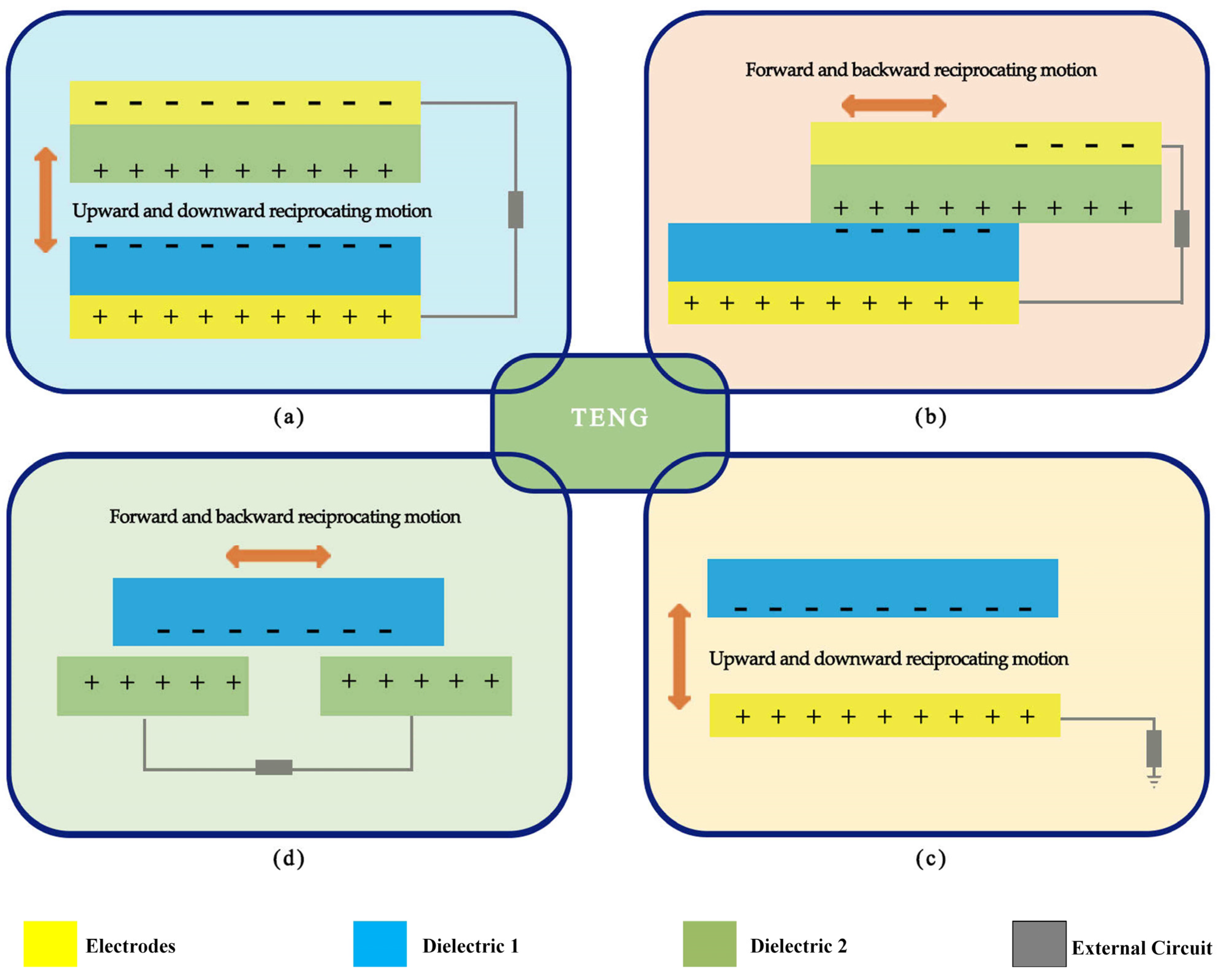

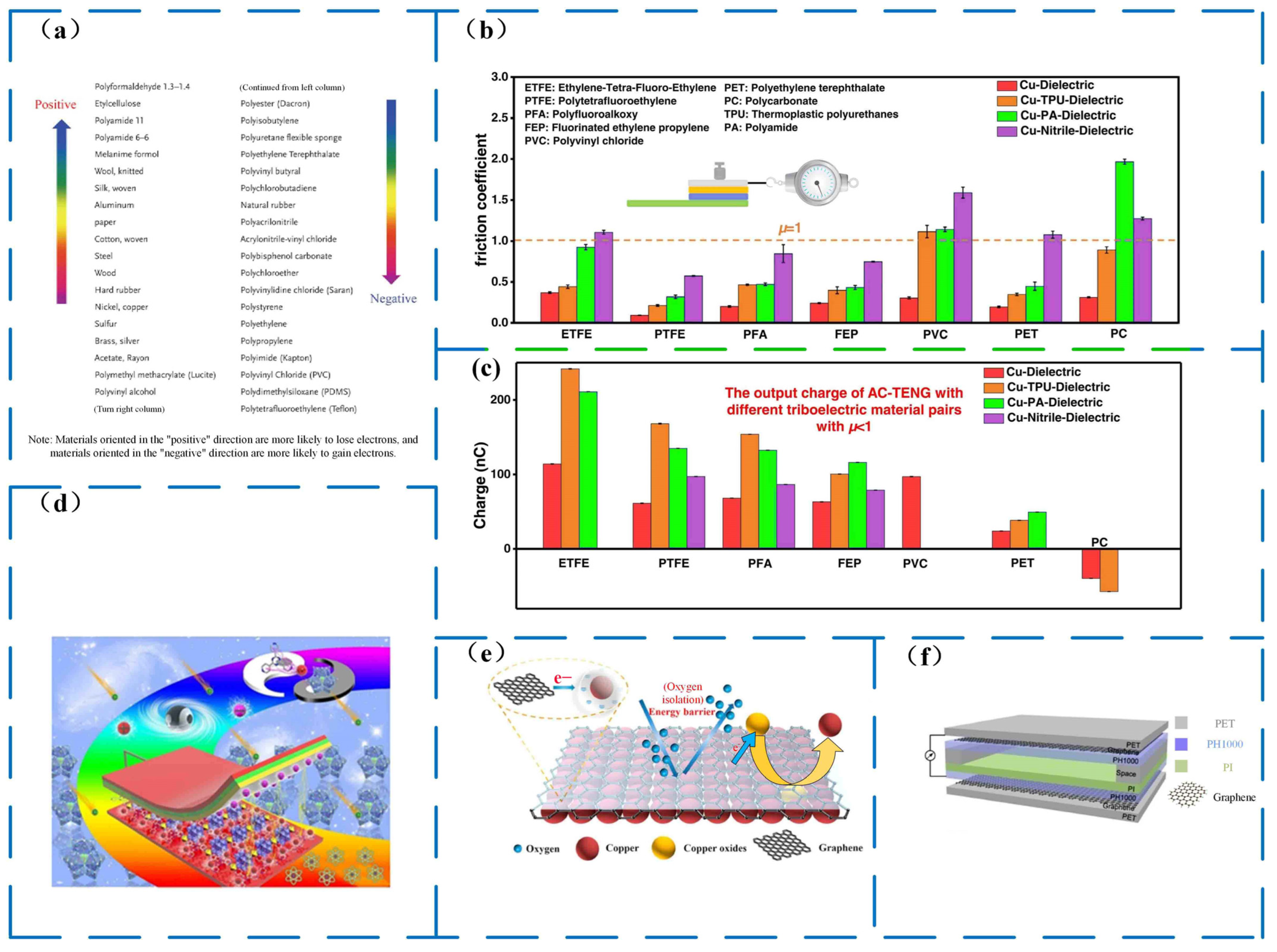
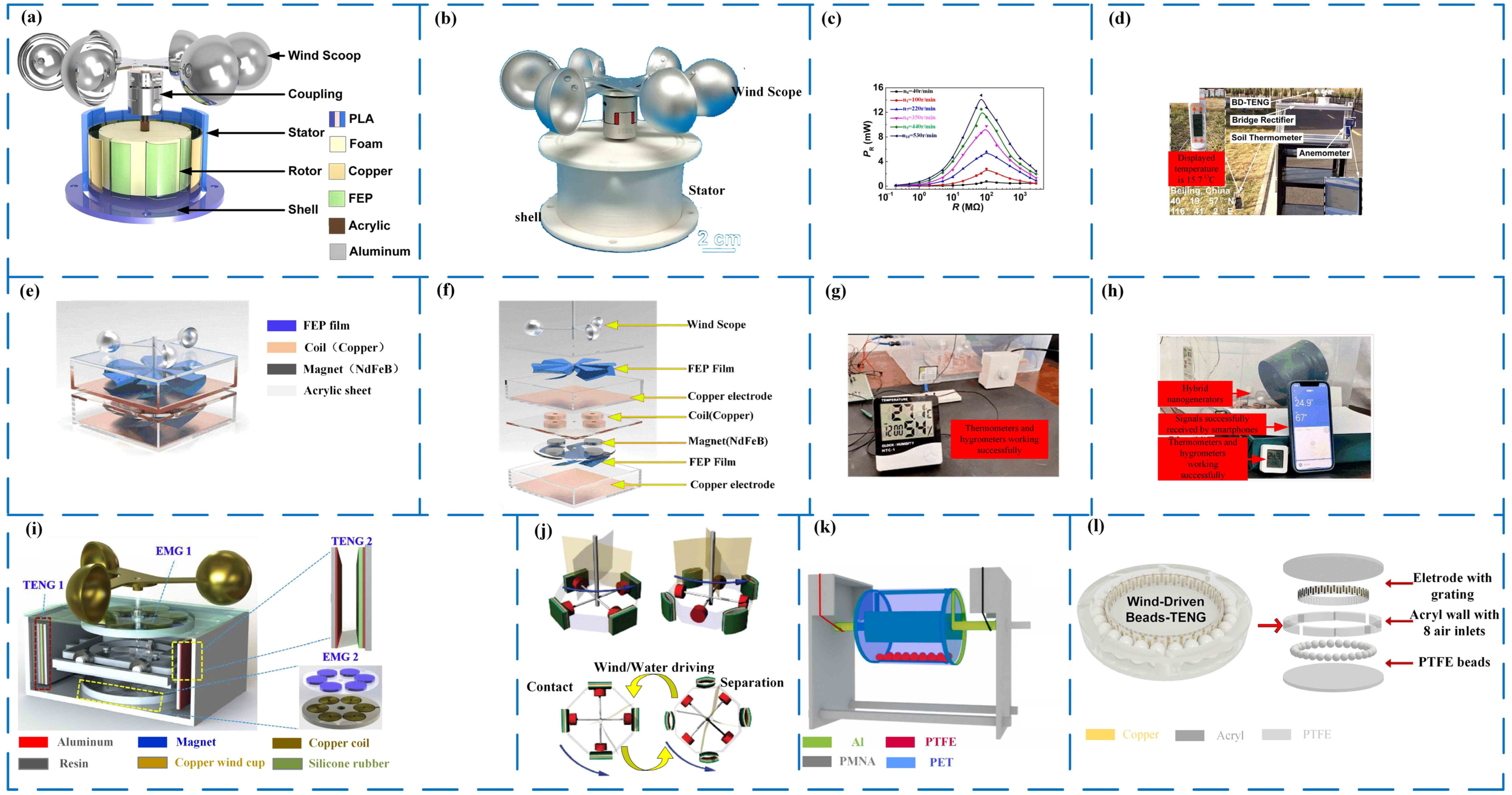


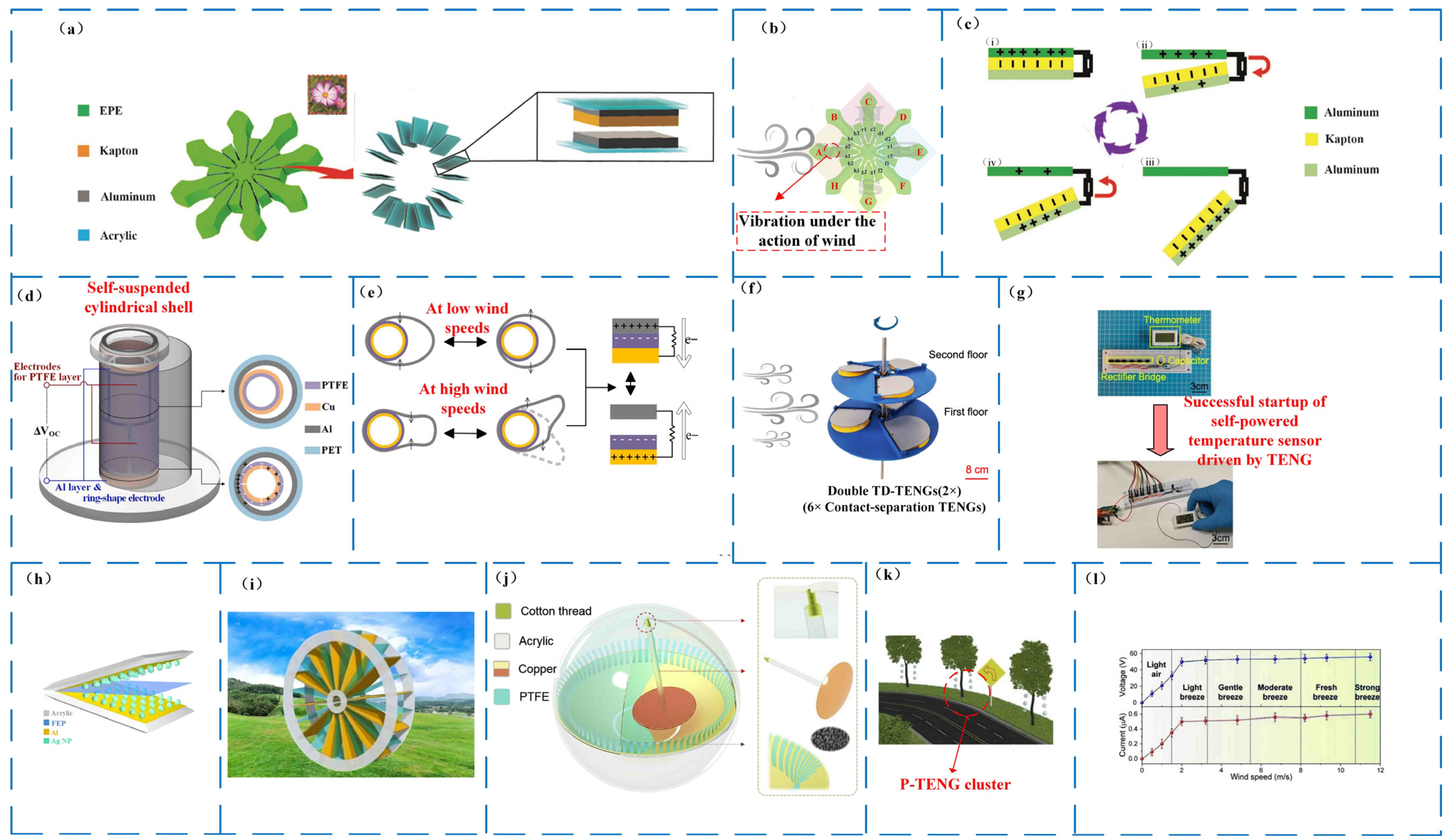
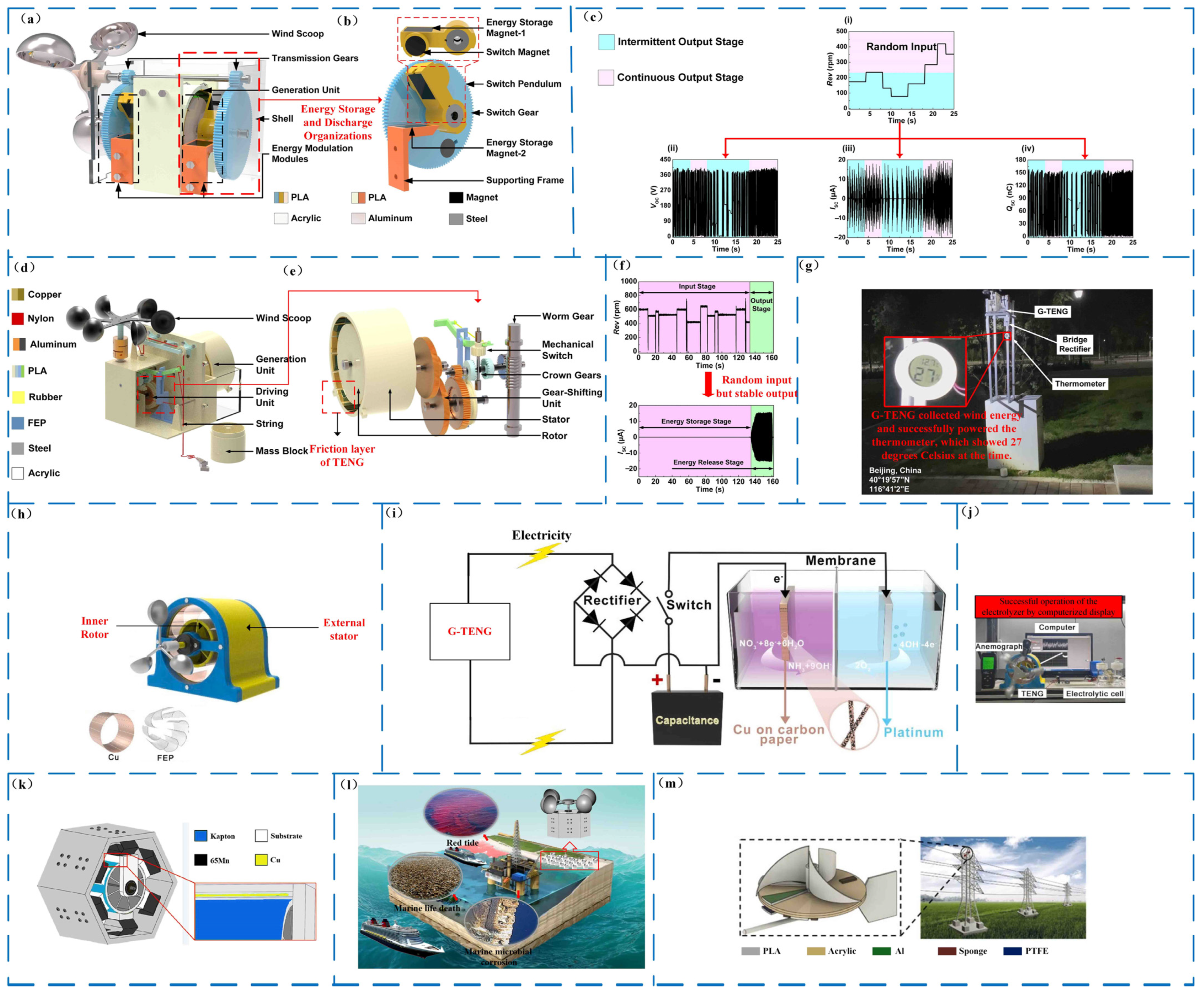
| Author | TENG | Starting Wind Speed | Maximum Wind Speed | Open-Circuit Voltage (V) | Short-Circuit Current | Power Density and Power |
|---|---|---|---|---|---|---|
| Li et al. [61] | BD-TENG | 3.3 m/s | 12 m/s | 330 | 7 µA | 2.81 mW |
| Ying et al. [62] | Triboelectric-electromagnetic Nanogenerator | 2.6 m/s | 6 m/s | 84 | 40 mA | 118.38 mW |
| Fan et al. [63] | TEHG | 4 m/s | 15 m/s | 479.2 | 1.9 mA | 18.96 mW |
| Huang et al. [64] | Magnetic-assisted Noncontact Triboelectric Nanogenerator | 2 Hz | 6 Hz | 206 | 30 µA | 3 mW |
| Zhu et al. [65] | RTS-TENG | 5 m/s | 144 | 1.23 µA | ||
| Jin et al. [66] | WB-TENG | 3 m/s | 10 m/s | 18.5 | 2.3 µA |
| Author | TENG | Starting Wind Speed | Maximum Wind Speed | Open-Circuit Voltage (V) | Short-Circuit Current | Power Density and Power |
|---|---|---|---|---|---|---|
| Song et al. [69] | DAS-TENG | 4 m/s | 6 m/s | 300 | 1.7 A | 633.44 mW |
| Zhong et al. [70] | RTS-TENG | 2 m/s | 7 m/s | 0.6 | 3.6 μA | 0.78 mW/m2 |
| Guang et al. [74] | BD-TENG | 7 m/s | 480 | 12 μA | 0.96 W/m2 |
| Author | TENG | Starting Wind Speed | Maximum Wind Speed | Open-Circuit Voltage (V) | Short-Circuit Current | Power Density and Power |
|---|---|---|---|---|---|---|
| Zou et al. [56] | TENG-SS | 2 m/s | 12 m/s | 558 V | 2.79 mW | |
| Wang et al. [76] | SA-TENG | 5 m/s | 13.2 m/s | 500 V | 21 μA | 7.69 mW |
| Author | TENG | Starting Wind Speed | Maximum Wind Speed | Open-Circuit Voltage (V) | Short-Circuit Current | Power Density and Power |
|---|---|---|---|---|---|---|
| Yuan et al. [78] | WG-TENG | 1 m/s | 8.1 m/s | 350 V | 6 μA | 149 mW/m2 |
| Zhang et al. [80] | GTENG | 1 m/s | 2 m/s | 220 V | 7 μA | 4.3 μW |
| Zhang et al. [81] | VIV-TENG | 1.66 m/s | 2.78 m/s | 450 V | 29 µA | 4.8 mW |
| Zhu et al. [82] | W-TENG structure after adding channels | 0.4 m/s | 15 m/s | 150 V | 0.6 mW | |
| Chen et al. [83] | B-TENG | 1.6 m/s | 8 m/s | 175 V | 43 μA | 2.5 mW |
| Zhao et al. [84] | C-TENG | 15 m/s | 61.7 V | 0.34 μA | 11.7 mW/m2 | |
| Gao et al. [85] | Self-suspended shell-based triboelectric nanogenerator | 0.3 m/s | 10 m/s | 47.6 V | 8.43 mW/m2 | |
| Gao et al. [86] | TD-TENG | 230 V | 9 µA | 0.37 mW | ||
| Lin et al. [87] | Individual AS-TENG | 4 m/s | 25 m/s | 120 V | 40 µA | 0.82 mW |
| Lin et al. [88] | Individual P-TENG | 0 m/s | 2 m/s | 56 V | 0.5 μA |
Disclaimer/Publisher’s Note: The statements, opinions and data contained in all publications are solely those of the individual author(s) and contributor(s) and not of MDPI and/or the editor(s). MDPI and/or the editor(s) disclaim responsibility for any injury to people or property resulting from any ideas, methods, instructions or products referred to in the content. |
© 2023 by the authors. Licensee MDPI, Basel, Switzerland. This article is an open access article distributed under the terms and conditions of the Creative Commons Attribution (CC BY) license (https://creativecommons.org/licenses/by/4.0/).
Share and Cite
Yan, J.; Tang, Z.; Mei, N.; Zhang, D.; Zhong, Y.; Sheng, Y. Research Progress on the Application of Triboelectric Nanogenerators for Wind Energy Collection. Micromachines 2023, 14, 1592. https://doi.org/10.3390/mi14081592
Yan J, Tang Z, Mei N, Zhang D, Zhong Y, Sheng Y. Research Progress on the Application of Triboelectric Nanogenerators for Wind Energy Collection. Micromachines. 2023; 14(8):1592. https://doi.org/10.3390/mi14081592
Chicago/Turabian StyleYan, Jin, Zhi Tang, Naerduo Mei, Dapeng Zhang, Yinghao Zhong, and Yuxuan Sheng. 2023. "Research Progress on the Application of Triboelectric Nanogenerators for Wind Energy Collection" Micromachines 14, no. 8: 1592. https://doi.org/10.3390/mi14081592
APA StyleYan, J., Tang, Z., Mei, N., Zhang, D., Zhong, Y., & Sheng, Y. (2023). Research Progress on the Application of Triboelectric Nanogenerators for Wind Energy Collection. Micromachines, 14(8), 1592. https://doi.org/10.3390/mi14081592






